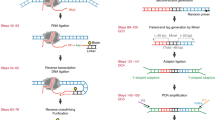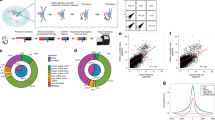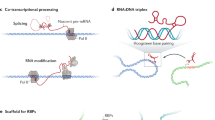Abstract
Little is known about the functional domain architecture of long noncoding RNAs (lncRNAs) because of a relative paucity of suitable methods to analyze RNA function at a domain level. Here we describe domain-specific chromatin isolation by RNA purification (dChIRP), a scalable technique to dissect pairwise RNA-RNA, RNA-protein and RNA-chromatin interactions at the level of individual RNA domains in living cells. dChIRP of roX1, a lncRNA essential for Drosophila melanogaster X-chromosome dosage compensation, reveals a 'three-fingered hand' ribonucleoprotein topology. Each RNA finger binds chromatin and the male-specific lethal (MSL) protein complex and can individually rescue male lethality in roX-null flies, thus defining a minimal RNA domain for chromosome-wide dosage compensation. dChIRP improves the RNA genomic localization signal by >20-fold relative to previous techniques, and these binding sites are correlated with chromosome conformation data, indicating that most roX-bound loci cluster in a nuclear territory. These results suggest dChIRP can reveal lncRNA architecture and function with high precision and sensitivity.
This is a preview of subscription content, access via your institution
Access options
Subscribe to this journal
Receive 12 print issues and online access
$209.00 per year
only $17.42 per issue
Buy this article
- Purchase on Springer Link
- Instant access to full article PDF
Prices may be subject to local taxes which are calculated during checkout






Similar content being viewed by others
Accession codes
References
Batista, P.J. & Chang, H.Y. Long noncoding RNAs: cellular address codes in development and disease. Cell 152, 1298–1307 (2013).
Lee, J.T. & Bartolomei, M.S. X-inactivation, imprinting, and long noncoding RNAs in health and disease. Cell 152, 1308–1323 (2013).
Guttman, M. et al. Chromatin signature reveals over a thousand highly conserved large non-coding RNAs in mammals. Nature 458, 223–227 (2009).
Mercer, T.R., Dinger, M.E. & Mattick, J.S. Long non-coding RNAs: insights into functions. Nat. Rev. Genet. 10, 155–159 (2009).
Guttman, M. & Rinn, J.L. Modular regulatory principles of large non-coding RNAs. Nature 482, 339–346 (2012).
Ule, J., Jensen, K., Mele, A. & Darnell, R.B. CLIP: a method for identifying protein-RNA interaction sites in living cells. Methods 37, 376–386 (2005).
Hafner, M. et al. Transcriptome-wide identification of RNA-binding protein and microRNA target sites by PAR-CLIP. Cell 141, 129–141 (2010).
Helwak, A., Kudla, G., Dudnakova, T. & Tollervey, D. Mapping the human miRNA interactome by CLASH reveals frequent non-canonical binding. Cell 153, 654–665 (2013).
Chu, C., Qu, K., Zhong, F.L., Artandi, S.E. & Chang, H.Y. Genomic maps of long noncoding RNA occupancy reveals principles of RNA-chromatin interactions. Mol. Cell 44, 667–678 (2011).
Simon, M.D. et al. The genomic binding sites of a noncoding RNA. Proc. Natl. Acad. Sci. USA 108, 20497–20502 (2011).
Engreitz, J.M. et al. The Xist lncRNA exploits three-dimensional genome architecture to spread across the X chromosome. Science 341, 1237973 (2013).
Yang, L. et al. lncRNA-dependent mechanisms of androgen-receptor-regulated gene activation programs. Nature 500, 598–602 (2013).
Rossetto, C.C., Tarrant-Elorza, M., Verma, S., Purushothaman, P. & Pari, G.S. Regulation of viral and cellular gene expression by Kaposi's sarcoma-associated herpesvirus polyadenylated nuclear RNA. J. Virol. 87, 5540–5553 (2013).
Colak, D. et al. Promoter-bound trinucleotide repeat mRNA drives epigenetic silencing in fragile X syndrome. Science 343, 1002–1005 (2014).
Conrad, T. & Akhtar, A. Dosage compensation in Drosophila melanogaster: epigenetic fine-tuning of chromosome-wide transcription. Nat. Rev. Genet. 13, 123–134 (2012).
Straub, T., Gilfillan, G., Maier, V.K. & Becker, P.B. The Drosophila MSL complex activates the transcription of target genes. Genes Dev. 19, 2284–2288 (2005).
Alekseyenko, A.A. et al. A sequence motif within chromatin entry sites directs MSL establishment on the Drosophila X chromosome. Cell 134, 599–609 (2008).
Ilik, I.A. et al. Tandem stem-loops in roX RNAs act together to mediate X chromosome dosage compensation in Drosophila. Mol. Cell 51, 156–173 (2013).
Kind, J. et al. Genome-wide analysis reveals MOF as a key regulator of dosage compensation and gene expression in Drosophila. Cell 133, 813–828 (2008).
Soruco, M.M.L. et al. The CLAMP protein links the MSL complex to the X chromosome during Drosophila dosage compensation. Genes Dev. 27, 1551–1556 (2013).
Meller, V.H. & Rattner, B.P. The roX genes encode redundant Male-Specific-Lethal transcripts required for targeting of the MSL complex. EMBO J. 21, 1084–1091 (2002).
Park, S.W. et al. An evolutionarily conserved domain of roX2 RNA is sufficient for induction of H4-Lys19 acetylation on the Drosophila X chromosome. Genetics 177, 1429–1437 (2007).
Stuckenholz, C., Meller, V.H. & Kuroda, M.I. Functional redundancy within roX1, a noncoding RNA involved in dosage compensation in Drosophila melanogaster. Genetics 164, 1003–1014 (2003).
Kelley, R.L., Lee, O.K. & Shim, Y.K. Transcription rate of noncoding roX1 RNA controls local spreading of the Drosophila MSL chromatin remodeling complex. Mech. Dev. 125, 1009–1019 (2008).
Zuker, M. Mfold web server for nucleic acid folding and hybridization prediction. Nucleic Acids Res. 31, 3406–3415 (2003).
Maenner, S., Müller, M., Fröhlich, J., Langer, D. & Becker, P.B. ATP-dependent roX RNA remodeling by the helicase maleless enables specific association of MSL proteins. Mol. Cell 51, 174–184 (2013).
Sexton, T. et al. Three-dimensional folding and functional organization principles of the Drosophila genome. Cell 148, 458–472 (2012).
Grimaud, C. & Becker, P.B. The dosage compensation complex shapes the conformation of the X chromosome in Drosophila. Genes Dev. 23, 2490–2495 (2009).
Simon, M.D. et al. High-resolution Xist binding maps reveal two-step spreading during X-chromosome inactivation. Nature 504, 465–469 (2013).
Wang, K.C. et al. A long noncoding RNA maintains active chromatin to coordinate homeotic gene expression. Nature 472, 120–124 (2011).
Lai, F. et al. Activating RNAs associate with Mediator to enhance chromatin architecture and transcription. Nature 494, 497–501 (2013).
Bailey, T.L. & Elkan, C. Fitting a mixture model by expectation maximization to discover motifs in biopolymers. Proc. Int. Conf. Intell. Syst. Mol. Biol. 2, 28–36 (1994).
Chu, C., Quinn, J.J. & Chang, H.Y. Chromatin isolation by RNA purification (ChIRP). J. Vis. Exp. 61, e3912 (2012).
Gupta, R.A. et al. Long non-coding RNA HOTAIR reprograms chromatin state to promote cancer metastasis. Nature 464, 1071–1076 (2010).
Zhang, Y. et al. Model-based analysis of ChIP-Seq (MACS). Genome Biol. 9, R137 (2008).
Rashid, N.U., Giresi, P.G., Ibrahim, J.G., Sun, W. & Lieb, J.D. ZINBA integrates local covariates with DNA-seq data to identify broad and narrow regions of enrichment, even within amplified genomic regions. Genome Biol. 12, R67 (2011).
Subramanian, A. et al. Gene set enrichment analysis: A knowledge-based approach for interpreting genome-wide expression profiles. Proc. Natl. Acad. Sci. USA 102, 15545–15550 (2005).
Groth, A.C., Fish, M., Nusse, R. & Calos, M.P. Construction of transgenic Drosophila by using the site-specific integrase from phage PhiC31. Genetics 166, 1775–1782 (2004).
Acknowledgements
We thank members of the Chang and Akhtar labs, P. Sharp and X. Wu (Massachusetts Institute of Technology) for meaningful discussion and E. Larschan (Brown University) for CLAMP antibody. Supported by US National Institutes of Health R01-CA118750 and R01-ES023168 (H.Y.C.), Max Planck Society (A.A.) and Bio-X Fellowship (J.J.Q.). This work was supported by DFG-funded SFB992 and SFB746 and EU-funded EpiGeneSys awarded to A.A. H.Y.C. is an Early Career Scientist of the Howard Hughes Medical Institute; A.A. is part of the BIOSS excellence initiative.
Author information
Authors and Affiliations
Contributions
J.J.Q., I.A.I., P.G., C.C., H.Y.C. and A.A. designed the research. J.J.Q., I.A.I. and P.G. performed the research. K.Q. and J.J.Q. performed bioinformatic analyses. J.J.Q. and H.Y.C. wrote the manuscript. All authors discussed the results and reviewed the manuscript.
Corresponding author
Ethics declarations
Competing interests
The authors declare no competing financial interests.
Supplementary information
Supplementary Text and Figures
Supplementary Figures 1–7 (PDF 2985 kb)
Supplementary Table 1
Supplementary Table 1 (XLSX 25 kb)
Rights and permissions
About this article
Cite this article
Quinn, J., Ilik, I., Qu, K. et al. Revealing long noncoding RNA architecture and functions using domain-specific chromatin isolation by RNA purification. Nat Biotechnol 32, 933–940 (2014). https://doi.org/10.1038/nbt.2943
Received:
Accepted:
Published:
Issue Date:
DOI: https://doi.org/10.1038/nbt.2943
This article is cited by
-
Novel insights into the role of long non-coding RNA in the human malaria parasite, Plasmodium falciparum
Nature Communications (2023)
-
Global DNA and protein interactomes of FLT1P1 (Fms-related tyrosine kinase 1 pseudogene 1) revealed its molecular regulatory functions associated with preeclampsia
Molecular Biology Reports (2023)
-
Identification of long noncoding RNAs involved in resistance to downy mildew in Chinese cabbage
Horticulture Research (2021)
-
The pan-cancer lncRNA PLANE regulates an alternative splicing program to promote cancer pathogenesis
Nature Communications (2021)
-
Non-coding RNAs in cancer: platforms and strategies for investigating the genomic “dark matter”
Journal of Experimental & Clinical Cancer Research (2020)



